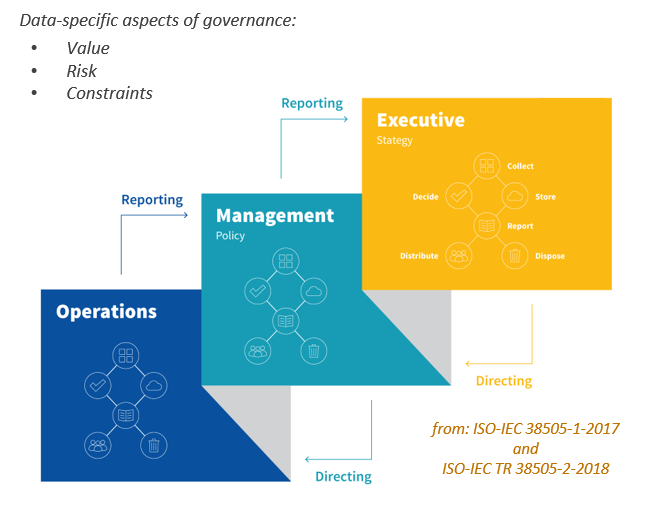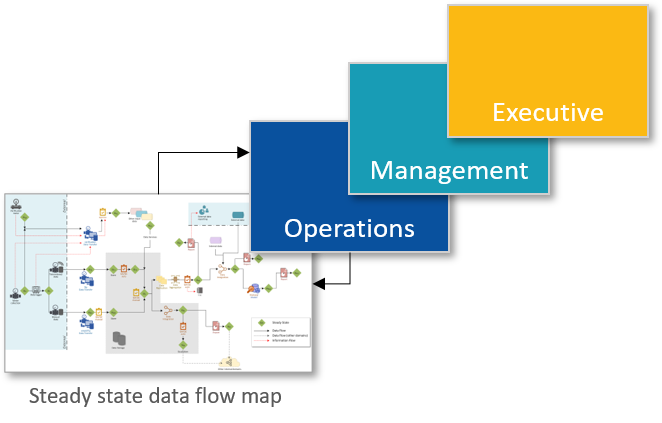A high-level summary of the approach to data governance that guides implementation of the operational Data Governance Framework and use of Steady State Data Flow mapping. This paper was written by Kevin Sweeney.
Summary paper: Holistic data governance [PDF 340 KB]
Approaches to data governance are typically based on a traditional political governance model, which is markedly hierarchical and fuelled by a top-down perspective.
This approach is designed to generate value primarily by capturing and delivering the experience and insights of those at senior levels and ensuring organisational vision and data strategy messaging is available when data assets are developed and leveraged.
However, a decidedly top-down approach can also engender a disconnection with organisational operational environments, so that in those contexts data governance is considered irrelevant or even worse, a burden, to staff.
A data governance approach based exclusively in top-down also does not inherently open corresponding channels for operational perspectives and experience to extend upward and influence strategic thinking. This can result in strategies and plans that are unrealistic or otherwise not feasible within existing operational realities, meaning outcomes are not achieved.
Moreover, without a practical value proposition for data governance, operational staff can become disconnected from the organisational data strategy delivered through the governance framework, potentially contributing to reduced levels of staff engagement.
To deliver in a meaningful way as data infrastructure, data governance needs to be relevant and able to operate effectively across all levels of the enterprise. Staff situated at different levels of the enterprise will necessarily maintain a view of data governance based in their own contexts, but it is also critical for the good of the organisation that these views align in a cohesive fashion.
The organisation’s approach to data governance therefore needs to be holistic in nature, ensuring not only that staff at a particular level derive benefit from it, but also that those same staff are equipped to govern data in conjunction with and in support of those operating at other levels.
ISO has published an international standard for data governance which provides a consistent set of accountability areas and data-specific parameters of those areas for the organisation, which is amenable to a holistic approach.
The opportunity to leverage these practical elements from the ISO data governance standard in conjunction with a perspective that treats data governance holistically, offers an option to increase the value proposition of data governance within the organisation.
Leverages elements of the published ISO standard on data governance [ISO-IEC 38505-1-2017 and ISO-IEC TR 38505-2-2018] applied across three general enterprise levels:
Employs a set of six data accountability areas from the the ISO standard as a consistent means of assessing data governance across the three enterprise levels:
Each enterprise level accountability area is measured in terms of three data-specific aspects of governance as delineated in the ISO standard:
When defined in this way, these measures generate a “cascading scorecard” of consistent assessment across executive, management and operational levels, facilitating a joined-up view of data governance across the organisation, and a holistic approach overall (Figure 1).

Figure 1. Holistic Data Governance employing the ISO data governance standard
The scorecard approach results in an eighteen-cell matrix for each level, consisting of the six accountability areas expressed in terms of their value, risks and constraints.
The resulting output provides a valuable source of insights with which to develop a data strategy that aligns with existing organisational strategy and long-term plans. It can help an organisation identify and leverage the value of its data assets, in a realistic fashion (i.e., in the context of relevant risks and constraints).
The use of the holistic approach furthermore positions organisations to leverage an operational Data Governance Framework, including a steady state data flow map. Positioned within the Operations level, the data flow map provides an intuitive and effective means of expressing perspectives which can inform Management and Executive outputs (Figure 2). The decision criteria associated with steady states also provide a means of embedding policy and strategic considerations directly into operational workflow.

Figure 2. Leveraging steady state data flow mapping for the holistic data governance approach
At the same time, the holistic approach supports traditional top-down data governance and its use of oversight mechanisms (boards and committees) to reflect and deliver the authority and responsibilities of the organisation’s governing body. When data governance is considered holistically, the governing body is better positioned to manage its accountability across all organisational contexts and corresponding perspectives on data.
When considered together, the value, risks and constraints measures help delineate three types of organisational current state in terms of data:
The means available to organisations to respond to each of these states will vary, but may very well align primarily with one of the three enterprise levels as follows:
The use of a consistent assessment model across all three enterprise levels facilitates a whole-of-enterprise consideration of data governance, such that each level can contribute its unique perspective in a meaningful way.
If you’d like more information, have a question, or want to provide feedback, please email datalead@stats.govt.nz.
Content last reviewed 02 July 2021.